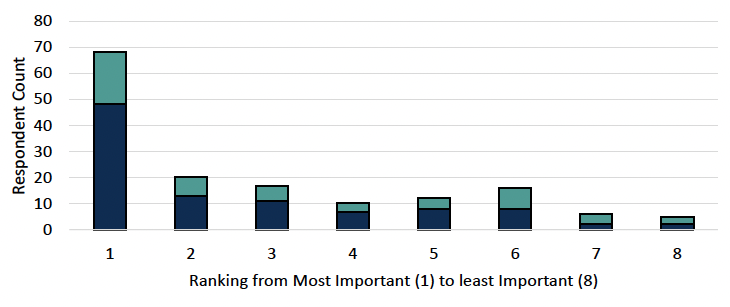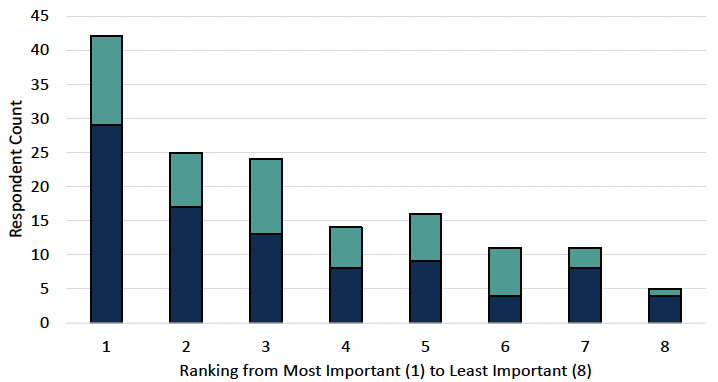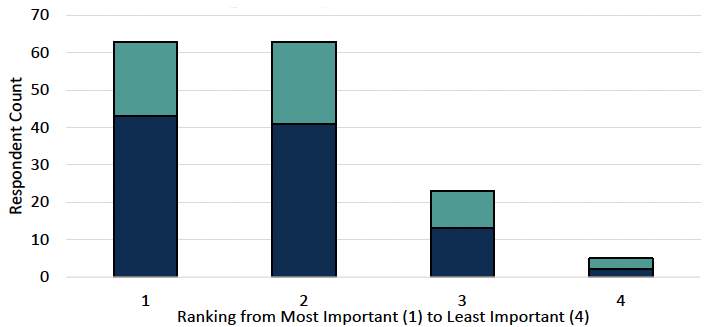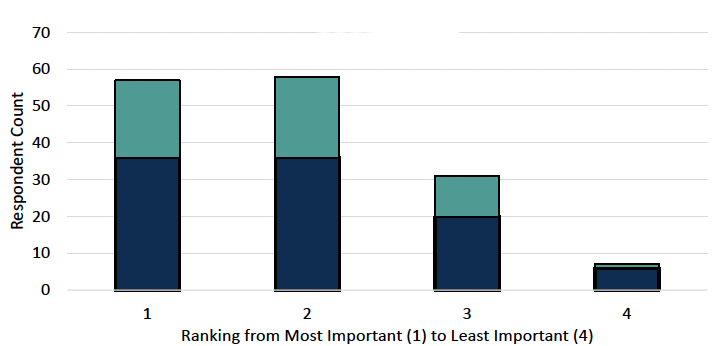National Flood Resilience Strategy: consultation analysis
Analysis of the responses to the National Flood Resilience Strategy consultation exercise.
3. Processes
Creating flood resilient places will mean adapting the processes for making decisions related to flooding, including how delivery partners are supported to deliver a broader range of actions and how spending is prioritised. For example, some funding for new, large flood protection schemes might be redistributed to other actions such as a property flood protection grants, natural flood management measures or training and equipping community resilience groups.
Question 15: How might information, guidance, direction and technical support be provided for communities and flood management organisations?
Around 170 respondents answered Question 15.
Organisational functions
Some respondents commented on the role of specific organisations. An Environmental or planning body observed that local authorities and public bodies should take the lead in helping the public understand the information relevant to them. SEPA, the Scottish Flood Forum, and Scottish Government were referenced, as were Development Trusts, and local authorities, with the staff skills and expertise of the latter two specifically highlighted. A Community Council or group respondent argued that any advice given should be impartial and separate from companies with vested interests, with the Scottish Flood Forum given as example of an agency able to provide independent advice.
Some respondents gave suggestions on the role of SEPA, including the agency:
- Being resourced to form teams to inspect and advise businesses and communities, if they are deemed to be at flood risk.
- Providing data and information, including detailed flood maps for stakeholders.
- Using technical experts to review flood related studies to ensure they are based on sound science and data.
- Engaging directly with communities.
The need for better cross-organisational collaboration when working with communities was mentioned by a Community Council or group respondent; it was suggested that Scottish Water, SEPA, and the local authority should all attend the same meetings.
The role of elected members was touched on by some Individual respondents. They supported elected members being given training so that they would have the necessary knowledge on flooding and the associated risks when meeting communities. Local authority planning teams were considered as requiring specific training in flood risk and it was suggested that, in general, trust in professionals working in the sector could be enhanced by continuing professional development with respect to adapting to climate change.
One suggestion, from a Community Council or group respondent was that a new environment agency should be set up, with powers to impose sanctions. Other respondents proposed the creation of a Scottish Government Flood Resilience Department, with ring-fenced funding and powers. It was also suggested that the Scottish Government should produce a clearer legal framework for responsibilities covering water management and property protection.
There was support from some respondents for national approaches, to ensure better co-ordination and use of resources. Suggestions on what could be managed, produced or delivered at a national level included:
- Strategy on the provision of support to flood affected areas.
- A flood resilience cross-sectoral working group.
- Reporting and data collection.
- A single source point for information, help, and support.
- Relevant strategies and guidance brought together in one resource document.
Working with communities to disseminate information, guidance, direction and support
Community Councils and Flood Resilience Groups were highlighted as an avenue for spreading information more widely. Where not already in place, it was suggested that there could be encouragement for Flood Resilience Groups to be set up in communities. Regional Land Use Partnerships were also mentioned as being useful forums, as were Catchment Management Partnerships.
The need for good communication when working with communities was referenced, as was tailoring approaches to local circumstances, including geographical risks and populations. Existing strategies, such as Coastal Change Adaptation Plans, should also be taken into account.
The value of networking and of sharing experiences, best practice, successful examples, innovative solutions, and case studies was highlighted with a suggestion that the centralised planning hub proposed by the Scottish Government in its consultation on resourcing the planning system could be used to support this activity. There was also support from for community access to independent experts, for technical advice and support.
Accessing information and support
There was noticeable support for a single online access point for information, whether a dedicated website or an online portal, providing members of communities with easier access to information, guidance and technical support.
Other suggestions for delivering information, advice and support to communities and flood management organisations included:
- Training sessions and workshops.
- Public forums and meetings.
- Community events/activities.
- Awareness raising campaigns.
- Creating resource for schools, youth clubs or faith groups.
- Creating community champions.
- Providing access to expert advice or to face-to-face advice.
- Peer-to-peer knowledge sharing.
- Using local press, radio or television channels.
- Drop-in centres (for example in schools, supermarkets, museums, libraries or a travelling bus).
Community Learning and Development teams and existing third sector infrastructure were mentioned as being able to provide support for various activities.
The need to consider the accessibility of communications was also stressed, with suggestions including creating Plain English and Easy Read versions of information, explaining technical terms, and considering creating captioned videos.
Including flood risk information in Home Reports, or providing Flood Performance Certificates to reflect a property’s flood risk were also seen as ways of disseminating property-specific information.
Question 16: How can we improve efficiency, consistency and value in delivering flood actions?
Around 160 respondents answered Question 16.
Organisational issues
An argument was made in favour of nationally co-ordinated, centralised resources and support. For example, a Public body respondent argued that while spreading responsibilities for flooding across several organisations has benefits, it can result in resource challenges, with differing organisational priorities. In contrast, centralised management and oversight would improve efficiency, value and consistency. Proposals made by other respondents included:
- Creation of a single, national organisation responsible for flood risk and managing drainage networks.
- Management of flood schemes resting with national bodies, working to national priorities and across local authority boundaries, using a flood management framework that includes Community Councils.
A Flooding or land management business respondent suggested there could be better understanding of risk nationally and locally through detailing homes at risk, and any risk reduction due to new flood defences.
A national approach to technical standards was also seen as desirable, as was a national programme of mapping and modelling improvements to deliver consistent and cohesive baseline dataset, helping to build evidence and understanding. Use technologies such as GIS and real time hydrological monitoring, to improve flood forecasting and risk mapping were suggested, along with online monitoring, smart devices, sensors, CCTV and drones.
There were also calls to streamline existing bureaucracy to increase efficiency and value for money. It was argued that there are currently too many forms, too much paperwork and too many reports to complete.
Centralised information
A national website, providing information and guidance, and the ability for relevant agencies able to share data and information was suggested by some respondents. This resource could also be used for centralised flood reporting, and co-ordination of emergency responses, thereby building up a national database of flood related information, encouraging collaborative working and generating feedback on approaches.
Other ideas included:
- A portal that can be accessed by local people, organisations and businesses, with information available by catchment area.
- A centralised advisory service, with a single source increasing consistency, and reducing duplication.
- A central resource for all flood resilience action plans, providing guidance on best practice.
Some respondents expressed a view that there should be standardised flood risk protocols for risk assessments, response strategies, recovery processes, and mitigation.
Partnerships and co-ordination
Some respondents highlighted the importance of partnerships and the need for co-ordination across different, but related policy areas. Suggestions included:
- Developing partnerships that align planning activities and investment across stakeholders focused on developing water resilient places.
- Co-ordinating projects so that other goals do not impact negatively on flooding and flood resilience.
- Looking beyond flood risk at where benefits can be aligned with other initiatives – such as those focused on social, economic, environmental issues.
- Awareness of other benefits in flooding projects, including positive impacts on related areas such as biodiversity or air quality.
- Combining the funding and management of flood resilience projects with those tackling climate resilience.
It was suggested that joining up strategies would be cost effective, and that funding allocated to a range of interlinked challenges could be used to address these in a holistic way.
Funding
Some respondents commented on funding, including on the limitations of timelines. Suggested improvements included:
- Ensuring that funding delivery timescales consider the design and consents process otherwise, by the time funding is in place costs may have risen dramatically, with impacts for that particular project.
- Reducing the delay between design and implementation by restructuring how capital funding is allocated.
- Changing the balance from one-off spending capital funding to operational funding which is more adaptable and focused on ongoing improvement and maintenance.
- Setting timelines that allow time for partnerships to work together on funding bids.
- Changing the support mechanisms for agriculture and land management as these can deliver flood resilience actions but are not included as specific outcomes of schemes or in the appraisal of schemes.
- Creating better alignment between flood related activities and various other funding streams including, the Forestry Grant Scheme, Rural Payments, Nature Restoration Fund and Peatland Restoration Fund.
Other suggestions in relation to funding included setting up a Scottish Government funded Property Flood Resilience grant scheme and raising funds towards flooding measures through higher developer contributions.
Drainage and maintenance issues
Some respondents focused specifically on drainage and maintenance issues including clearing drains and ditches and maintaining drainage systems. It was suggested that while communities can carry out inspections there must be follow-up. Other points raised included:
- Ensuring that utility companies leave drains intact, once off-site.
- If roads are retarred, ensuring that gullies are in the correct place.
Biodiversity and ecology
Other views related to issues of biodiversity, ecology and wider environmental concerns. An Environmental or Planning body respondent noted that uptake of sustainable approaches, including natural flood management techniques, is currently low and that more could be done to manage freshwater environments in natural, sustainable way. It was also suggested that when evaluating flood management measures, broader environmental and biodiversity benefits, should be considered.
Community
Reflecting points raised at earlier questions, suggestions included:
- Using Local Place Plans to empower communities to address flood risks.
- Making full-time community liaison and support professionals available to support communities.
- Enabling access to technical support and the ability to commission independent consultants for second opinion on projects.
- Creating a national network of community flood groups, with investment in training and support.
Question 17: Other than large flood protection schemes, what other flood resilience actions should we focus on supporting/spending available funding on? (Please rank by importance)
Seven options were presented at this question:
- Maintaining existing flood protection
- Small flood protection schemes
- Natural flood management
- Blue and green infrastructure (e.g. multi-purpose greenspace, such as floodable sports pitches)
- Flood forecasting and warning
- Property level flood resilience measures
- Supporting local community flood resilience groups.
Around 180 respondents answered this question.
Preferred options
By some margin, respondents thought Scotland should focus on supporting or funding ‘natural flood management’; 68 respondents saw this option as most important. ‘Maintaining existing flood protection’ was also seen as important, being ranked first by 42 respondents and as second by a further 25 respondents. ‘Flood forecasting and warning’ tended to be seen as least important.


‘Other’ suggestions
Around 70 respondents made a further comment in relation to the ‘Other’ option.
Among suggestions for ‘other’ flood resilience actions that should be supported, the options selected most frequently were:
- Local or community-based education, including awareness raising and flooding preparedness. There was specific reference to the Scottish Flood Forum’s work to raise awareness of flood risk in communities and appropriate mitigation and preparedness actions.
- Funding flood risk management measures, including through a balanced, risk-based approach, including supporting large scale flood prevention schemes where appropriate.
- Providing incentives, grants, and funding support schemes. The Nature Restoration Fund, Agriculture Support Schemes, Forestry Grant Schemes and Scottish Flood Forum’s Community Action scheme were given as examples.
- Individual property/household specific measures, including retrofitting or abandonment/relocation, in particularly high flood risk locations.
- Enabling local authorities, by ensuring they have both adequate powers and funding for managing flood risk. A specific suggestion was giving local authorities powers to recover expenses from landowners if they have to intervene to reduce flood risk because of inaction by the landowner.
There were also a range of general comments relating to supporting the Just Transition, including around aligning flood management with broader climate adaptation goals, and nature-based solutions.
Less frequent suggestions included:
- Improving foul and surface water drainage networks.
- Improving access to flood insurance.
- Supporting training and development for professionals.
Question 18: Do you think there is enough evidence and information to support the delivery of a broader range of flood resilience actions? If No, please let us know what you think our evidence and information gaps are.
Responses to Question 18 by respondent type are set out in Table 5 below.
| Type of respondent | Yes | No | Total |
|---|---|---|---|
| Community council or group | 8 | 7 | 15 |
| Environmental or planning body or group | 5 | 3 | 8 |
| Flooding or land management group or business | 2 | 2 | 4 |
| Local authority or regional planning group | 7 | 9 | 16 |
| Professional or representative body | 4 | 3 | 7 |
| Public body or agency | 6 | 3 | 9 |
| Third sector or political group | 2 | 0 | 2 |
| Total organisations answered | 34 | 27 | 61 |
| % All organisations answered | 56% | 44% | n/a |
| Individuals answered | 46 | 53 | 99 |
| % All individuals answered | 46% | 54% | n/a |
| Total all respondents answered | 80 | 80 | 164 |
| % All respondents answered | 50% | 50% | n/a |
Respondents were evenly divided on whether there is enough evidence and information to support the delivery of a broader range of flood resilience actions.
Around 70 respondents went on to explain what they thought evidence and information gaps were. Key themes from their comments are summarised below.
General observations on the evidence base
Some respondents also made general observations about the importance of having a sufficient evidence base, including that it is important to understand the gaps to help with the introduction and delivery of any change. Other comments focused on ensuring that the wider body of evidence is accessible, including that information should be:
- Readily available. A specific suggestion was that one central website with all the relevant information would be more efficient and consistent. There was also a call for SEPA to release all of its data and the methodology it uses to assess flood risk.
- Presented in as accessible a format as possible; it was suggested that at present the general public’s level of understanding of technical terminology means that they are often excluded.
There were also a number of general observations or suggestions about how the overall evidence base could be improved and developed. These included that:
- Where possible, the information available across Scotland should be based on the same data gathering and assessment approaches; if there are differences in approach this could be made clear.
- There may be a case for some national guidance to help drive a degree of consistency and common understanding.
- The evidence base, including flood maps, needs to be kept up to date and improved and developed in line with the latest science and growing understanding of flood risk. Specific comments included that some current assessment approaches use data that is more than 10 years old.
A Public body respondent called for the development of a national programme to deliver a consistent and cohesive catchment/coastal scale baseline dataset suitable for designing flood resilience places. Other general suggestions about the types and focus of the evidence/information available were that it should include:
- Information and case studies illustrating the full range of grey, green and soft infrastructure solutions available.
- Methods for demonstrating and comparing the costs and benefits of different flood resilience measures.
- Equivalent information across the whole country; an associated comment was that there is currently better information available for the east than the west of Scotland.
Specific evidence or information gaps
Nature based solutions and natural flood management
There was a view that there is currently a lack of evidence about which types of NFM are most effective, albeit it was noted that the Eddleston Water Project is a good example of trying to address these data gaps by showing the effects of implementing such measures. Nevertheless, there were calls:
- For more case studies of NFM measures and evidence of the actual, measured effects they are having in terms of reducing flooding / making places more resilient.
- For information relating to effectiveness of NFM at scale.
- To provide decision makers with improved resources derived from natural capital accounting approaches, such as NFM Benefits Valuation, to show more fully the ‘financially valued’ benefits of NFM to human well-being, wider society and biodiversity.
Specific nature-based actions about which respondents would like to see more information included:
- Reforestation or wetland restoration.
- Water gardens and blue and green drains.
- Improving the microbial health of our soils and the plant content of our permanent grasslands to increase the water holding capacity.
- The use of green roofs.
Implications of climate change
A number of respondents were looking for more and/or up-to-date information on the expected impact of climate change, including both future options and the likely efficacy of existing flood protection schemes. It was suggested that we need more information about immediate actions we can take to combat climate change to help address the increasing flood risk and that communities need more information about how to build resilience locally.
Area-based information
Some respondents addressed the need for information relating to particular geographies or at community level. There were calls for more or better information relating to:
- Coastal areas. It was suggested that the coast remains overlooked and that this needs to be addressed. Further comments included that nearshore bathymetry is poorly mapped and that Scotland’s tide gauge and wave buoy network is far, far lower density than the UK, Ireland and our European neighbours.
- Catchment areas (including at sub-catchment level), river basins and flood plains. Specific comments included that there is a lack of local information on the flooding potential of feeder rivers.
Other comments addressed the need for local information, including at a community level. It was suggested that, while there is likely to be suitable evidence to underpin a high-level strategy, there is not sufficient information to implement solutions at a local level. Understanding the opportunities for NFM within a local area or region was given as an example.
There was also a suggestion that citizen science could be used to increase the awareness and involvement of communities and develop very localised models.
Question 19: What other funding sources or mechanisms could be used to support flood resilience? (Please rank by importance)
Three options were presented at this question:
- Financial contributions from those who directly benefit from improved flood resilience (e.g. private sector/businesses)
- All new development makes a contribution
- Support natural flood management through payments to farmers, crofters and land managers (for example, Forestry Grant Scheme, the future agricultural support framework or Peatland ACTION payments).
Around 175 respondents answered this question.
Preferred options
Of the three options, ‘all new development making a contribution’ and ‘payments to farmers, crofters and land managers’ were both seen as relatively important. ‘All new development making a contribution’ was the first choice of 63 respondents and ‘payments to farmers, crofters and land managers’ was the first choice of 57 respondents.


There was limited support for ‘financial contributions from those who directly benefit from improved flood resilience’, with 76 respondents ranking this option third.
‘Other’ suggestions
Around 65 respondents made a further comment in relation to the ‘Other’ option.
The most frequent funding related suggestion was that the Scottish Government should provide or investigate a range of funding measures. Some suggested taxation could be used to make this possible.
It was also suggested that existing/committed Scottish Government funding of projects or initiatives that could have an impact on building flood resilience should be ring fenced. Grant schemes for projects that are not core ‘flooding’ projects, but that provide flood risk benefits such as active travel and nature restoration, were given as examples.
Other funding-related suggestions included:
- Funding for and by local authorities. In terms of possible sources of that funding, it was suggested that councils could require larger planning gain contributions when approving housing developments or that funding for improved biodiversity, local recreational greenspace and cycle routes could be raised through council tax or water charges.
- Utilising more private finance, including by encouraging or requiring developers and other stakeholders to contribute to flood resilience initiatives beyond the strict boundaries of their development projects.
- Increasing/developing community focused funding initiatives, for example with communities able to bid for grant funding.
- Providing adequate funding/grants to encourage land management practices and usage that will help support flood resilience. The need to ensure that those creating more flood resilient landscapes are adequately compensated, especially where they cannot access other payment schemes, was highlighted.
Looking at insurance availability and affordability was also suggested. The potential for already high costs to increase still further if there is insufficient investment in improving flood resilience was seen as of major concern.
Contact
Email: flooding_mailbox@gov.scot
There is a problem
Thanks for your feedback